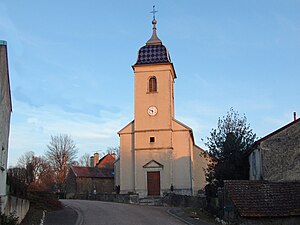Argillières
| Argillières | ||
|---|---|---|
|
|
||
| region | Bourgogne-Franche-Comté | |
| Department | Haute-Saône | |
| Arrondissement | Vesoul | |
| Canton | Dampierre-sur-Salon | |
| Community association | Quatre Rivières | |
| Coordinates | 47 ° 40 ′ N , 5 ° 38 ′ E | |
| height | 230-366 m | |
| surface | 9.58 km 2 | |
| Residents | 75 (January 1, 2017) | |
| Population density | 8 inhabitants / km 2 | |
| Post Code | 70600 | |
| INSEE code | 70027 | |
 Saint Martin Church |
||
Argillières is a municipality in the French department of Haute-Saône in the region Bourgogne Franche-Comté .
geography
Argillières is located at an altitude of 300 m above sea level, eleven kilometers northeast of Champlitte and about 56 kilometers northwest of the city of Besançon (as the crow flies). The village extends in the west of the department, in the plateau landscape between the valleys of Salon and Vannon , northwest of the Saône valley .
The area of the municipal area of 9.58 km² includes a section in the area of the gently undulating landscape north of the Saône valley. The plateau landscape is an average of 300 m and has several hollows and depressions, including the Combe des Charmes south of the village. The plateau consists of alternating layers of calcareous and sandy-marly sediments from the middle and upper Jurassic period . Agricultural use predominates on the plateau, but there are also larger areas of forest, especially along the municipal boundaries. In the north and east the plateau is bordered by the dry valley of the Vannon. The river flows underground in this area. The community area extends to the southwest to the forest heights of Mont Aubert with the Bois de l'Hospice , on which the highest point of Argillières is reached at 366 m. In the west, the hill of Saint-Martin (up to 359 m) forms the demarcation. There are no above-ground rivers in the entire area because the rainwater seeps into the karstified subsoil.
The hamlet of Velleguibelle (310 m) at the northern foot of the heights of Saint-Martin belongs to Argillières . Argillières' neighboring municipalities are Tornay and Gilley in the north, Fouvent-Saint-Andoche in the east and south, and Pierrecourt and Champlitte in the west.
history
Various finds of Silex -Werkzeugen point of its territory in a settlement Paleolithic out. In 1883, during excavations, the foundations of three houses from the Gallo-Roman period were discovered and a bronze brooch and numerous ceramic fragments were brought to light.
Argillières is mentioned in 1202 as Argilleres . The place name is derived from the Latin word argilla , meaning white clay . In the Middle Ages Argillières belonged to the Free County of Burgundy and in it to the area of the Bailliage d'Amont . In the 12th century, the local rule was held by the Lords of Fouvent, after which the place went to the rule of Ray . They left the tithe to Theuley Monastery in 1292. The place was plundered and pillaged by troops of the Duke of Zweibrücken in 1569. Argillières was also badly affected during the Thirty Years' War in 1636. Together with Franche-Comté , the village finally came to France with the Peace of Nijmegen in 1678. Today Argillières is a member of the community association Communauté de communes des Quatre Rivières, which comprises 42 localities .
Attractions
The single nave village church of Argillières was built in the 18th century and restored in 1985; In 2001 the bell tower was also renewed. It houses a statue of St. Martin from the 16th century. Other attractions include six Calvaires and the 17th and 18th century castle.
population
| Population development | |
|---|---|
| year | Residents |
| 1962 | 159 |
| 1968 | 137 |
| 1975 | 127 |
| 1982 | 100 |
| 1990 | 79 |
| 1999 | 78 |
| 2006 | 69 |
| 2017 | 75 |
With 75 inhabitants (January 1, 2017) Argillières is one of the smallest communes in the Haute-Saône department. During the entire 20th century, the population decreased continuously (in 1881 there were still 285 people).
Economy and Infrastructure
Argillières is still a predominantly agricultural (arable, fruit and cattle breeding) and forestry village. Outside of the primary sector there are few jobs in town. Some workers are also commuters who work in the larger towns in the area.
The village is located off the major thoroughfares on a department road that leads from Champlitte to Farincourt . Other road connections exist with Fouvent, Larret and Frettes.
